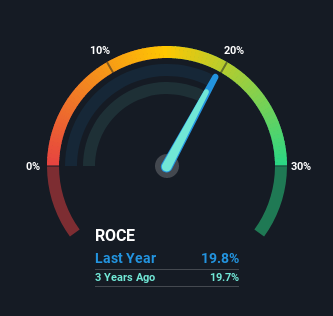Returns On Capital At James Hardie Industries (ASX:JHX) Have Hit The Brakes
If we want to find a potential multi-bagger, often there are underlying trends that can provide clues. Ideally, a business will show two trends; firstly a growing return on capital employed (ROCE) and secondly, an increasing amount of capital employed. If you see this, it typically means it's a company with a great business model and plenty of profitable reinvestment opportunities. So, when we ran our eye over James Hardie Industries' (ASX:JHX) trend of ROCE, we liked what we saw.
Return On Capital Employed (ROCE): What is it?
Just to clarify if you're unsure, ROCE is a metric for evaluating how much pre-tax income (in percentage terms) a company earns on the capital invested in its business. To calculate this metric for James Hardie Industries, this is the formula:
Return on Capital Employed = Earnings Before Interest and Tax (EBIT) ÷ (Total Assets - Current Liabilities)
0.20 = US$630m ÷ (US$4.1b - US$901m) (Based on the trailing twelve months to March 2021).
Thus, James Hardie Industries has an ROCE of 20%. In absolute terms, that's a satisfactory return, but compared to the Basic Materials industry average of 7.3% it's much better.
Check out our latest analysis for James Hardie Industries
Above you can see how the current ROCE for James Hardie Industries compares to its prior returns on capital, but there's only so much you can tell from the past. If you're interested, you can view the analysts predictions in our free report on analyst forecasts for the company.
The Trend Of ROCE
While the returns on capital are good, they haven't moved much. Over the past five years, ROCE has remained relatively flat at around 20% and the business has deployed 96% more capital into its operations. Since 20% is a moderate ROCE though, it's good to see a business can continue to reinvest at these decent rates of return. Over long periods of time, returns like these might not be too exciting, but with consistency they can pay off in terms of share price returns.
The Bottom Line On James Hardie Industries' ROCE
To sum it up, James Hardie Industries has simply been reinvesting capital steadily, at those decent rates of return. And the stock has done incredibly well with a 125% return over the last five years, so long term investors are no doubt ecstatic with that result. So even though the stock might be more "expensive" than it was before, we think the strong fundamentals warrant this stock for further research.
If you'd like to know about the risks facing James Hardie Industries, we've discovered 1 warning sign that you should be aware of.
For those who like to invest in solid companies, check out this free list of companies with solid balance sheets and high returns on equity.
This article by Simply Wall St is general in nature. It does not constitute a recommendation to buy or sell any stock, and does not take account of your objectives, or your financial situation. We aim to bring you long-term focused analysis driven by fundamental data. Note that our analysis may not factor in the latest price-sensitive company announcements or qualitative material. Simply Wall St has no position in any stocks mentioned.
Have feedback on this article? Concerned about the content? Get in touch with us directly. Alternatively, email editorial-team (at) simplywallst.com.

